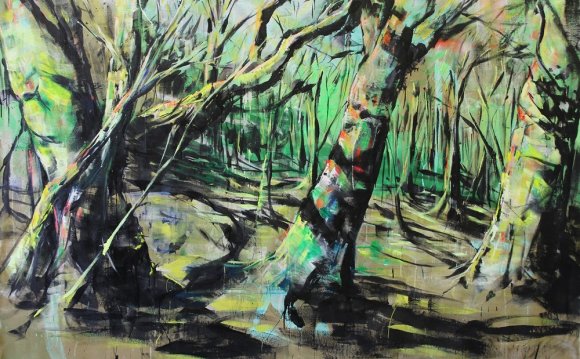
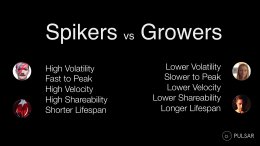 In the first part of this blog series (How Stuff Spreads | How Videos Go Viral part 1: Models of Virality) we identified 7 dimensions that describe and quantify virality. Although none of the variables alone proved able to define a viral phenomenon on their own, they correlated into two models of viral diffusion. One model we called “spike” – the sudden ‘explosion’ of sharing activity – and the other we called “growth”, where popularity is a slower and steadier grower.
In the first part of this blog series (How Stuff Spreads | How Videos Go Viral part 1: Models of Virality) we identified 7 dimensions that describe and quantify virality. Although none of the variables alone proved able to define a viral phenomenon on their own, they correlated into two models of viral diffusion. One model we called “spike” – the sudden ‘explosion’ of sharing activity – and the other we called “growth”, where popularity is a slower and steadier grower.
What makes a viral video spread in one or other of these ways? Most studies on the subject focus on virality as a feature of the content. But what if virality is (also) a feature of the audience? Can the demographics and the structure of the audience for a video explain how it goes viral?
To recap, we were studying 4 videos:
In this blog post we will show how we analysed the demographics and the social network properties of each video’s audience to understand better how they spread. Read on for some of our best network graphs yet and some fascinating findings…
Metric #1: Amplification and influence
The first thing we looked at is Amplification. Amplification is a measure of the average “visibility” of the tweets carrying the meme. Tweets with higher visibility imply a more influential status of the author who posted them. Can the influence level of the audience of a meme explain its slower or faster diffusion?
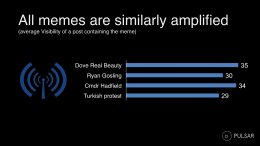
Amplificiation is similar across all audiences. It’s fractionally lower for the Turkish protest video and for Ryan Gosling, the first primarily shared in Turkey, the second appealing to a slightly newer (though still very active) Twitter audience. And it’s slightly higher for Dove Real Beauty Sketches and Commander Hadfield. In both cases the variation doesn’t correlate with the virality model of the meme.
Metric #2: How international were the audience?
So the next hypothesis to explain the velocity of the memes was the geographic distribution of the audience. We quantified this as Globality: the percentage of meme shares coming from countries other than the main country. So does the “internationalness” of a video affect its virality? Does a more global or a more local meme spread faster?
The answer is again, no. The Turkish protest video was “local” but so was Ryan Gosling – and one spread instantly but the other peaked on day 18. Since both Amplification and Globality seemed not to correlate with one or the other model of virality, we then looked at the demographics engaged with each video.
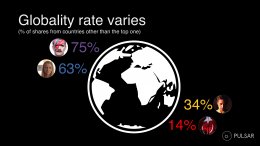 Metric #3: Demographics.
Metric #3: Demographics.
Does the demographics of the audience affect the way content goes viral? Do young, techie male students from global cities push a meme faster than, say, middle aged housewives from rural Germany?
We used Bayesian statistical inference to analyse the demographics of the audience. This method uses the available information on Twitter and matches it to a sample audience interviewed in real life to get known demographics, across the various countries involved in the study. Below is a summary of the most prominent demographics traits of the four audiences:
Although students and global cities feature heavily in all audiences, there doesn’t seem to be any direct correlation between virality models and demographic traits. Instead the demographics are completely different for each meme. Not to mention that students represent 33% of the Ryan Gosling audience, the slowest meme of all – so it seems that youth demographic probably isn’t necessarily a critical cause for a video to go viral quick.
And now some Social Network Analysis…
The audience gets more interesting when you start to look at its social structure. As we couldn’t find any correlation between demographic traits and virality models, we turned to the structure of the audience by mapping the social graph of the people who shared the video.
Your ‘social graph’ is the network of the people you know, and how they’re connected to each other. Because we were studying Twitter sharing of videos, we had easy access to this data through two variables: who each video sharer was following on Twitter, and who they’re followed by. In technical terms, this gives us a ‘directional’ network with two possible ways for nodes to be connected. Analysing these connections highlighted some really interesting differences.
 Metric #4: Degree, or ‘social connectedness’
Metric #4: Degree, or ‘social connectedness’
First of all we looked at the Average Degree of each audience network. Each person in a network can be assigned a ‘degree’ value: that’s a count of the number of connections they have to other people in the network. We were studying how videos spread in Twitter, so those connections are easy to identify: it’s who they’re following and who they’re followed by.
Interestingly enough, the audiences of the Spiker memes (Commander Hadfield and Turkish protests) are showing the highest levels of interconnectedness – while the audiences of the Grower memes (Dove Real Beauty and Ryan Gosling) show the lowest.
Metric #5: Modularity, or “fragmentedness”
The memes that spread faster could do so because the audiences that engaged with them were highly interconnected. But how are this connections organised? To do this we used another social network analysis metric called Modularity. This describes how fragmented the network is and how many sub-communities can be detected based on the density of mutual social connections within clusters of users.
The lower the modularity, the less fragmented the audience is into sub-communities, the more cohesive it is and the easier to reach it is. Not surprisingly, the audiences of the Spiker memes are the most cohesive ones, while the audiences of the Grower memes are the most fragmented ones. Cohesiveness and fragmentation becomes much easier to understand when looking at the total number of communities identified within each audience.
Metric #6: the number of Communities
Social network analysis tools allow you to measure the number of ‘communities’ in a social network. Tools such as Gephi provide access to algorithms, such as the Modularity one, that can quantify how people’ s connections tend to gather together into definable ‘clusters’ of closely-connected groups.
Whereas the audience of Commander Hadfield is split into 130 communities and the audience of the Turkish protests is split into 51, the audience of Ryan Gosling is split into 382 communities and the audience of Dove Real Beauty Sketches into 1356.
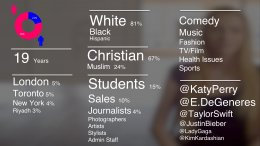
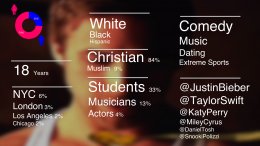

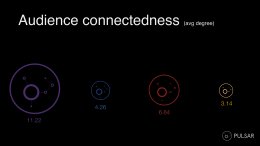
RELATED VIDEO












